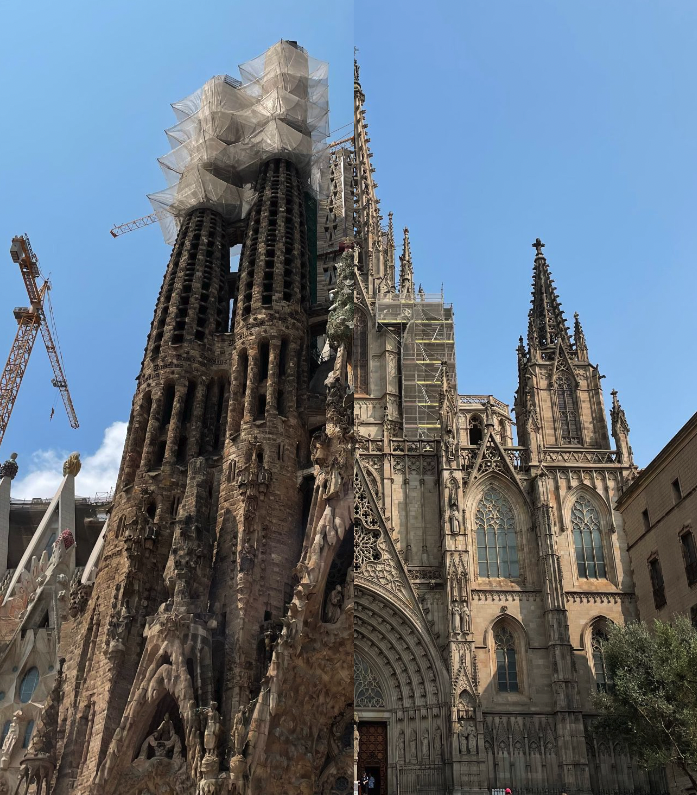
Left to right: Sagrada Família, Santa Eulalia Cathedral.
Introduction
If you ask, “What are the two most important cathedrals of Barcelona?” to anyone, they will probably answer by naming the Sagrada Família Basilica and Barcelona Cathedral (referred to here for clarity as Santa Eulalia Cathedral). And no wonder: one is Barcelona’s number one tourist attraction, bringing over three million visitors yearly, while the other was the city’s cultural and historical heart for centuries.
Which is odd, given that the two churches, at least at first glance, are wildly different from each other. One is 13th to 15th century; the other is 19th to 21st. One is primarily Gothic and neo-Gothic; the other is a riotous blend of architectural styles, described varyingly as Late Gothic, Catalan Modernist, or Art Nouveau. One is the classic image of a cathedral, imposing and austere; the other is colorful, richly decorated, and, famously, unfinished.
Given these differences, is it possible to draw any parallels between these two seemingly opposite buildings?
Exteriors
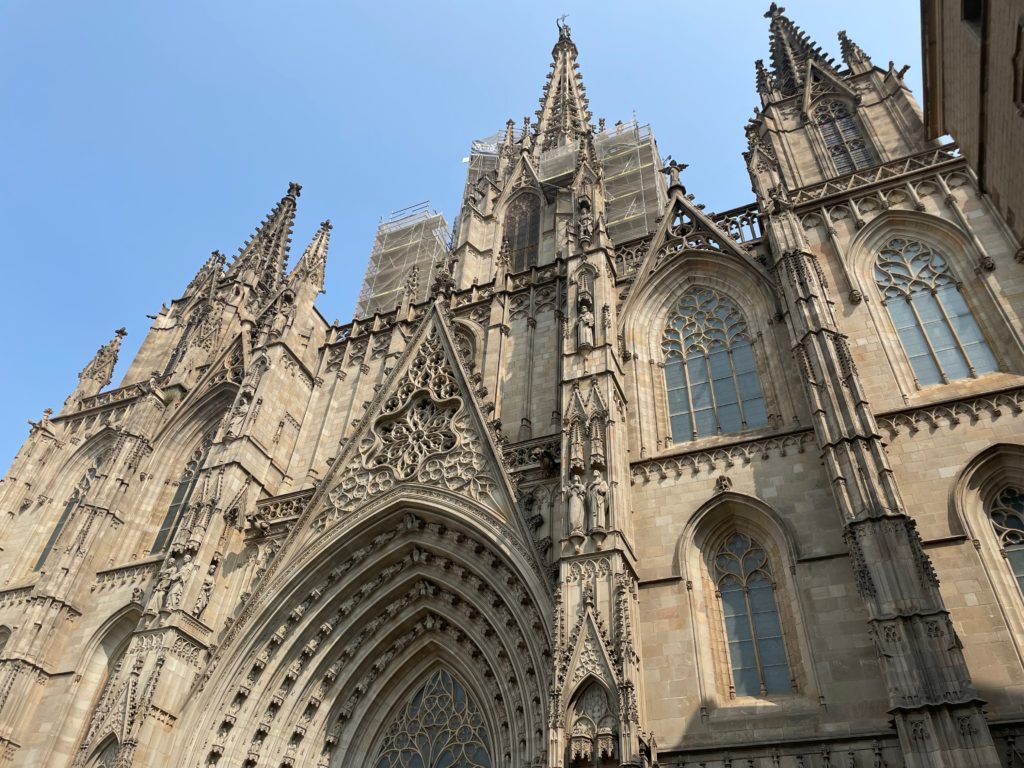
Santa Eulalia Cathedral, front façade; seen from Plaça Nova.
Of course, the part of any cathedral (and indeed, most buildings) that immediately captures the eye is the front face, of the façade. It’s also the most photographed part of the cathedral; when we visited the Sagrada Família, the spaces in front of the façades were absolutely packed with tourists snapping selfies. Although Santa Eulalia was considerably less crowded, this might have had more to do with the time we visited the cathedral (around 5 PM), as well as the considerably roomier space in front of Santa Eulalia.
We’ll start with Santa Eulalia. The front façade is unquestionably neo-Gothic, with its triple spires, its intricately carved panels, and its placement of the statues of saints… all quintessentially Gothic. I say neo-Gothic, though, because the façade actually doesn’t date back to the time the cathedral was built. In fact, the thirteenth-century western face was surprisingly simple until the late nineteenth century, when the spires were added. Overall, the façade is a classic example of the neo-Gothic.
The Sagrada Família, of course, is much more complicated than this, with its unique quirk of having three façades, all with their own unique design styles and architecture. Let’s start with the oldest face, the Nativity façade—the only face to have been completed in the lifetime of the architect, Antoni Gaudí.
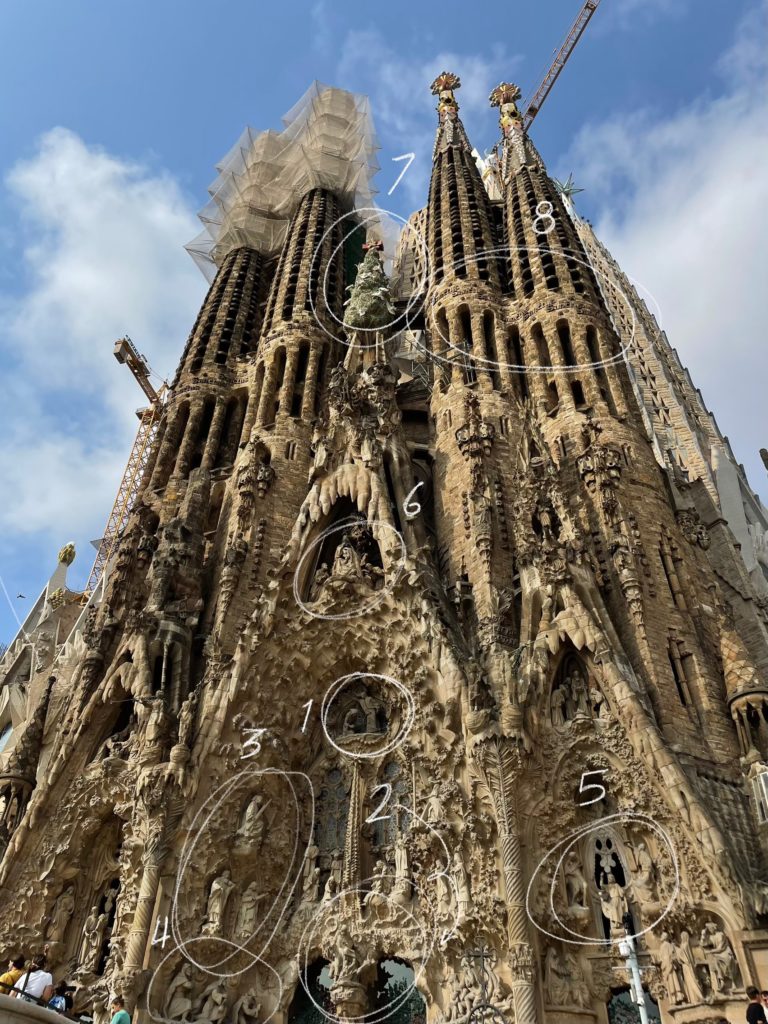
Sagrada Família, Nativity façade.
A common mistake many visitors make is the assumption that Antoni Gaudí was spiritually avant-garde, deviating from orthodox Catholic teachings, or that he was not spiritual at all. Nothing could be further from the truth. Throughout his entire life, Gaudí was a devout, sometimes fanatical, Catholic. The influence his faith had on his works can best be seen in the Nativity façade because this is the only façade that Gaudí lived to see completed. It can thus be said to be a genuine example of the architect’s vision for the basilica.
Teeming with depictions of flora and fauna, the Nativity façade is full of life and celebrates the birth of Christ. The narrative of the nativity, starting from the Annunciation (1) to the birth of Jesus (2), accompanied by a band of angels (3) and the three wise men (4), then moving on to the young Christ in the temple (5) and a humble image of the holy family (6), before being capped by a colorful cypress tree surrounded by doves (7) and the four towers bearing the word “Sanctus” (Latin for “holy”) (8), is carved with meticulous detail from stone, with many of the statues being cast from life through plaster. From painstakingly accurate depictions of people, leaves, animals, and angels, to the overall exuberance of the design, the façade feels celebratory. The overall effect of the face is one of joy and celebration of the birth of Christ.
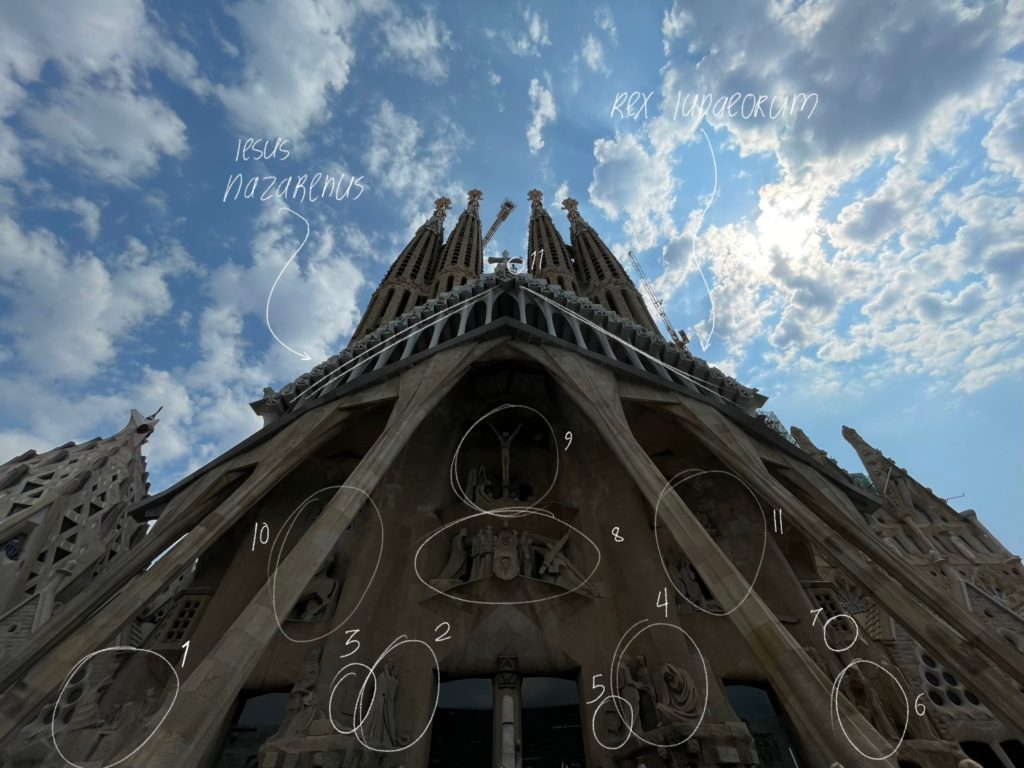
Sagrada Família, Passion façade.
In stark contrast to this vibrant and richly detailed face, the façade opposite to this, the Passion façade, is austere, bare, and sharply angular. This face of the cathedral was constructed far after Gaudí’s death, and the differences show: where the Nativity façade, telling the story of the Messiah’s entry into the world, is joyful and ornate, the Passion façade, telling the story of the Messiah’s brutal death, is bare and architecturally morose.
Like the Nativity façade, this face too primarily tells a story. The pillars are angular and resemble tendons or muscles, representing the physical aspect of Christ’s suffering. The narrative goes from the left to the right, then toward the very top. We start from the last supper (1), then towards the right to the infamous Kiss of Judas (2); the famous magic square (3) is also present, with all numbers in any direction adding up to the number 39, the age of Jesus when he died. (4) shows Peter’s denial of Jesus, with the apostle’s face wrought in grief; the rooster that crowed thrice (5) before Peter’s denial is also shown. Then it’s on to Pontius Pilate (6) deliberating during Jesus’ trial, with the Roman eagle (7) also shown.
Above the main doors, Christ’s walk to Golgotha, bearing the heavy cross, is shown (8), before the final suffering of the crucifixion (9). A stylized Roman soldier (10) and the burial of Jesus (11) are also shown. And above the whole façade, the words “Iesus Nazarenus Rex Iudaeorum” are written: this is Latin for “Jesus Christ, King of the Jews”, and was the message written above Christ’s head when he was crucified. But even in this bleak story, hope is not lost: a small statue of Jesus (11) is perched in between the four towers, representing his ascent into heaven.
And finally, although we didn’t have a chance to see the final, main face of the Sagrada Família, the Glory façade, construction on it has barely started, so we really didn’t miss much.
Overall, the faces of the Sagrada Família are much more narrative-driven than the façade of Santa Eulalia; whereas the faces of the former are built with the purpose of telling a grand, overarching story, the face of the latter was built with decoration in mind, not with narrative. And while the façade of Santa Eulalia is built with a single style, every face of the Sagrada Família is different.
This speaks to the length of time it took to build the respective façades. The unity of style present in the face of Santa Eulalia is unusual in most Gothic cathedrals; it’s due to the comparatively short time it took to build the façade separately. The opposite is true in the Sagrada Família, where the unity of style in the three faces of the building isn’t present because of the time it took to build them.
Interiors
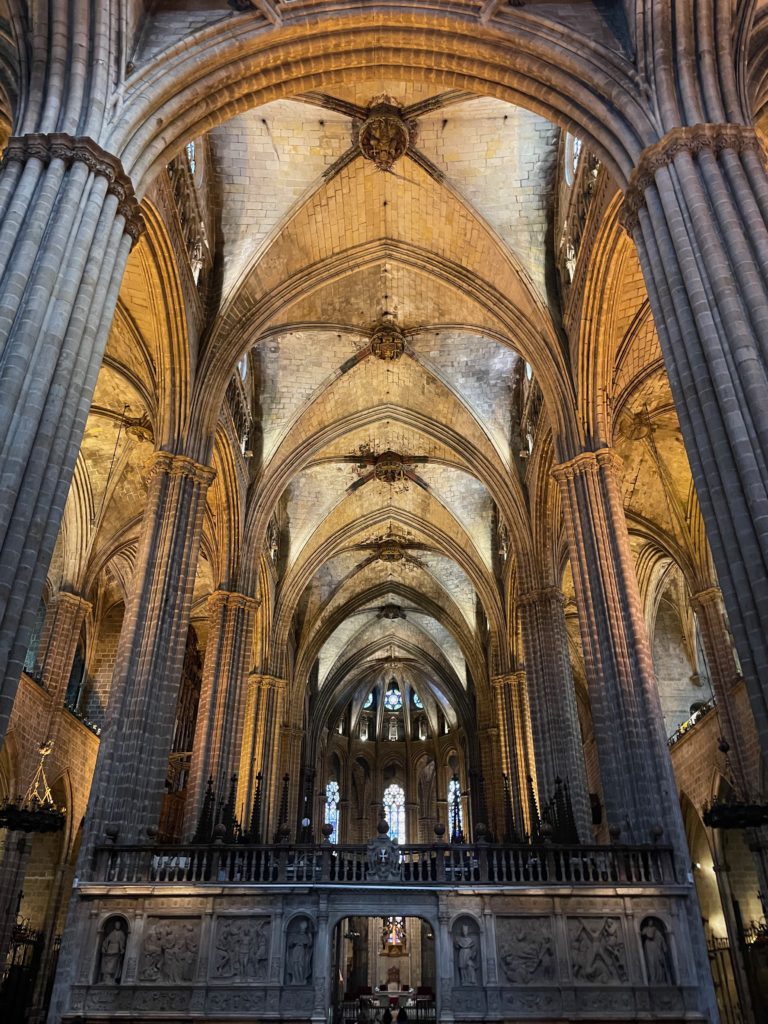
Nave of Santa Eulalia Cathedral, viewed from the entrance towards the apse.

Detail of the ceiling of Santa Eulalia Cathedral. Note the rib vault structure.
Visiting Santa Eulalia, we are immediately greeted by the nave, the vertical part of the cathedral’s cross structure, since the main entrance is there. The giant columns, stacked in tiers, support a brick rib-vaulted ceiling, a classic hallmark of Gothic cathedrals. The pointed Gothic arch is prominent throughout the building; some natural light comes through the windows, more prominently in the apse than in the nave, but most of the lighting is artificial. The interior of the cathedral seems dark, almost gloomy: this may be because of the cathedral’s position in Barcelona’s Gothic Quarter, where it is surrounded by buildings that block natural light from coming through the windows.
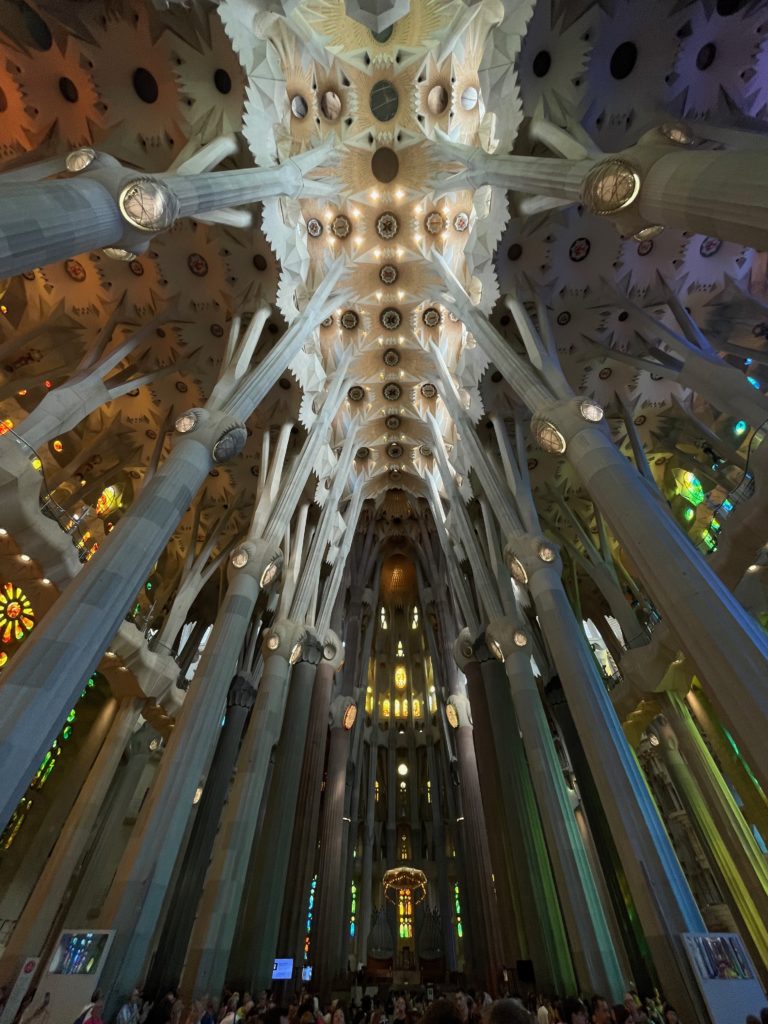
Detail of the ceiling of the Sagrada Família. Note the more naturalistic, “flowering” design.
In contrast to Santa Eulalia, the main entrance of the Sagrada Família is at the transept (the Nativity façade is at the right side of the transept), so visitors have to walk to the front of the cathedral to view the nave, as the main doors have not been opened yet. The most striking aspect of the Sagrada Família is unquestionably its color, coming from the Barcelona sunlight that passes through vibrantly colored stained-glass windows; it’s unquestionably natural, which may be due to the basilica’s position in the more rigidly planned Eixample district, where it towers above many residential buildings; more light can thus filter through, allowing for a brighter interior than that of Santa Eulalia.
Another striking detail is the design of the columns; unlike the classic tiered stone pillars that hold up pointed arches in Santa Eulalia, the columns of the Sagrada Família branch out towards the top and support a flowered ceiling (or perhaps a symbolic representation of a canopy of leaves) and, towards the top, a series of catenary arches. This design, combined with the fact that the sheer height of the basilica makes the columns look slender—in reality, they are incredibly wide—gives the feel of a stone forest, where the columns become naturalistically designed trees supporting fluid and non-rigid structures.
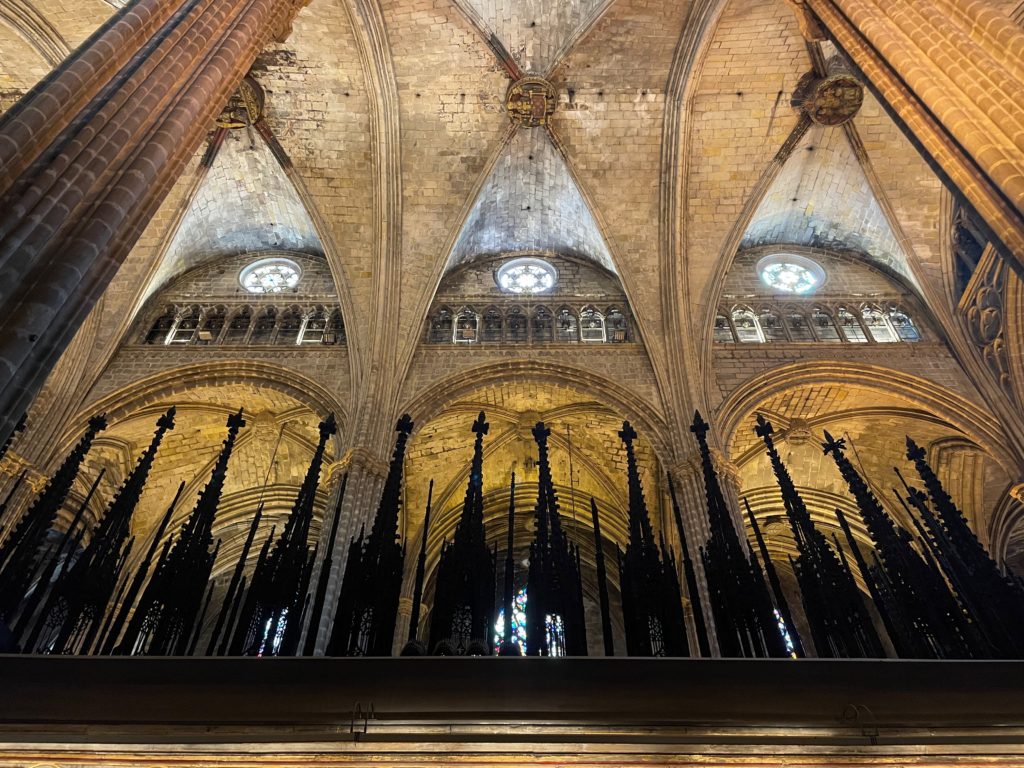
Stained glass windows of Santa Eulalia Cathedral, seen from the choir.
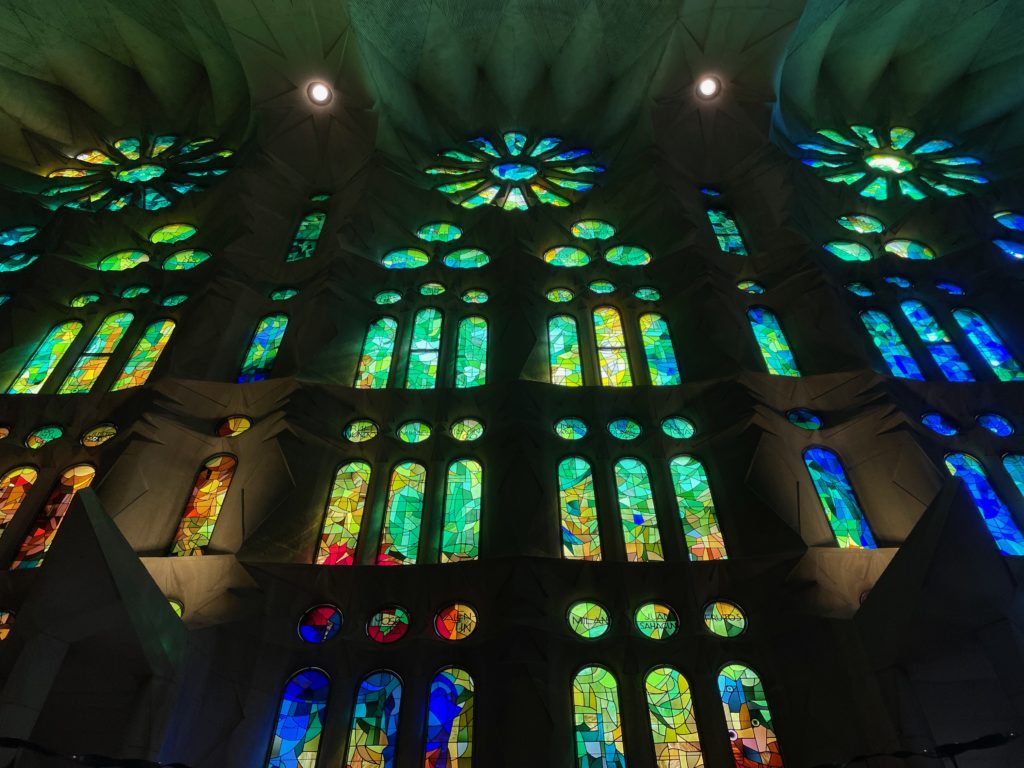
Stained glass windows of the Sagrada Família, seen from the nave side aisle.
Despite these differences, there are similarities between Santa Eulalia and Sagrada Família. The most prominent of these are the windows; both have fine stone tracery and a “rose” design, another hallmark of Gothic stained-glass windows. The windows of the Sagrada Família are overall more colorful, with a far greater selection of shapes and pieces than the windows of Santa Eulalia. However, they do feature the shape of the Gothic arch, in contrast to the catenary arches that are prevalent throughout the basilica.
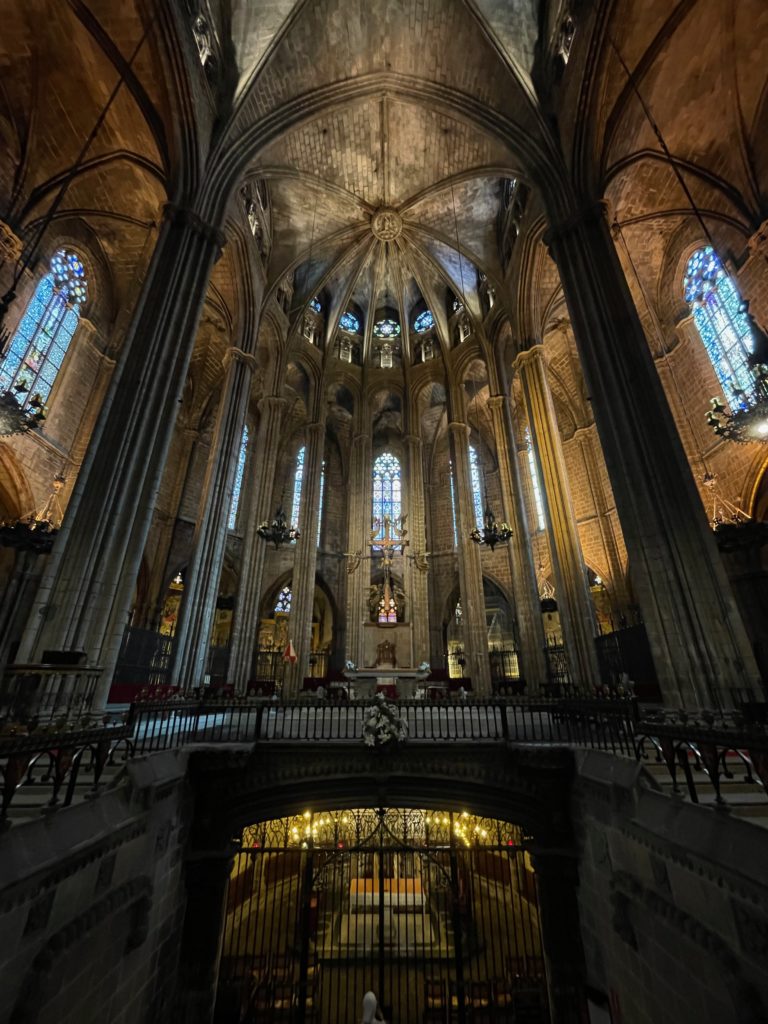
Apse of Santa Eulalia Cathedral.
Moving to the front of the cathedral, we come to the apse, perhaps the most important part of any cathedral: this is where services are held, where the speakers preach, and where the high altar is found.
For Santa Eulalia, the continuity of the space of the apse is partially disrupted by the entrance to the crypt, which is unusually in the open and sudden. This is where the namesake of the cathedral, Saint Eulalia, is buried. Behind the entrance is the apse proper, where the altar is. Compared to other cathedrals we visited, such as Toledo Cathedral, the apse of Santa Eulalia was surprisingly sparse; the main visual highlight of the space is the hanging sculpture of the crucified Christ surrounded by angels. The round walls of the apse feature lovely stained-glass windows, featuring the aforementioned tracery and rose shape of the classic Gothic style.
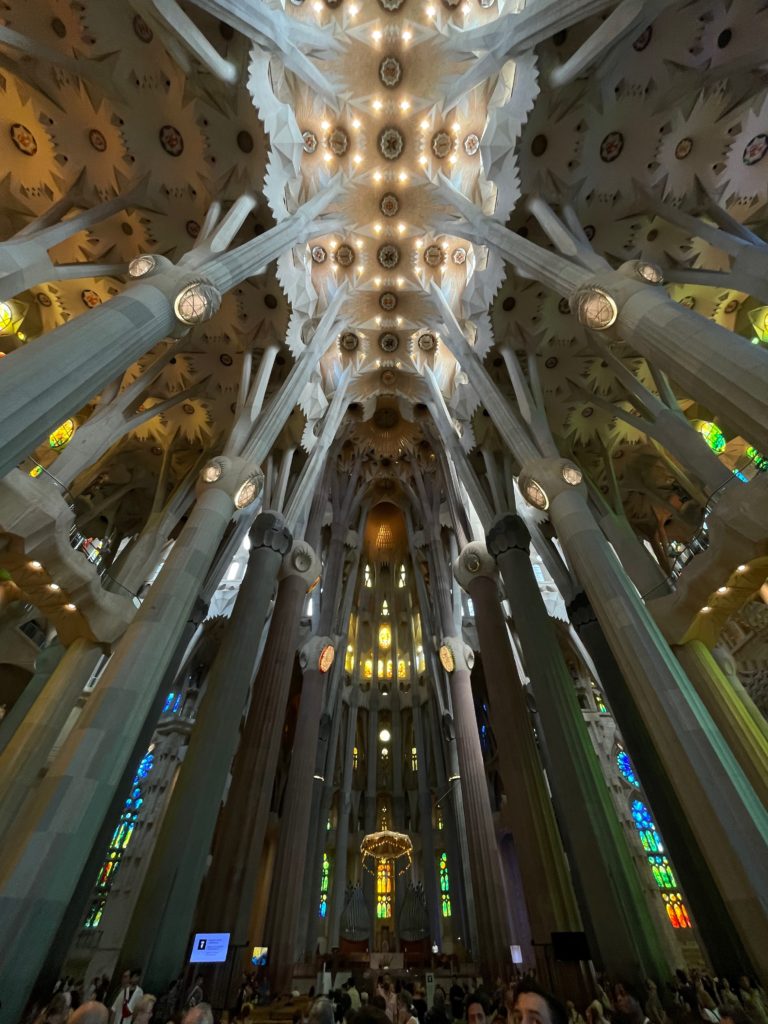
Apse of the Sagrada Família.
As a basic starting point, the apse of the Sagrada Família—indeed, the entirety of the Sagrada Família—is far larger than that of Santa Eulalia. As such, the apse simply feels more impressive; combined with the effect of the technicolor stream of light, it contrasts sharply with Santa Eulalia.
In the center of the apse is a hanging baldachin, or the canopy under which the bishop sits. Under it is another depiction of the crucifixion; coincidentally, it also floats off the ground in an almost abstract form. Behind the altar space are two organs, not present in Santa Eulalia, which play every half-hour or so. The sound of the pipes echoing through the basilica is a truly ethereal experience. Finally, the crypt, where Gaudí himself is buried, is situated directly under the apse, with a much subtler entrance than Santa Eulalia.
The traditional structure of the apse, that is, the reservation of the focal point of the nave and transept for the holiest space of the church, is the common tangent that ties the spaces of the two buildings together. Besides the altar, the hanging sculpture of the crucified Christ, and the elevated platform, it may seem hard to draw parallels between the two spaces. After all, Santa Eulalia doesn’t have the double organs that the Sagrada Família boasts; nor does it have the uninterrupted seating space that allows all eyes from the nave to be drawn to the apse.
But although these differences are important, it’s also important to note the many common architectural points that Antoni Gaudí intended in his work. As mentioned previously, the stained-glass windows are similar throughout the two buildings; the similarity is most prevalent in the apse, where the tracery and rose shapes especially shine through. And no wonder: in both buildings, the apse is the brightest part of the church. Finally, in both buildings, one of the most important people of the church is buried directly under the apse. For Santa Eulalia, it is its namesake; for the Sagrada Família, it is its architect. An affirmation of Christ’s triumph over death, perhaps, or a sign of honor.
Concluding thoughts
Santa Eulalia Cathedral and the Sagrada Família: Barcelona’s two great churches. One is a hallmark of medieval Gothic, the other is a hodgepodge of different styles over different decades. One is dark and solemn, the other is bright and airy. One is smaller and attracts fewer, the other is larger and attracts multitudes more. The differences go on.
Make no mistake, though: both are firmly grounded in Catholic tradition, architectural stability, and above all, faith. Though they may express it in radically different ways, at the end of the day, both buildings deserve a judgment on equal footing. They are both, in their own ways, beautiful statements of belief.